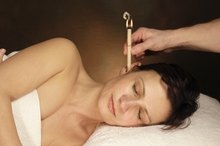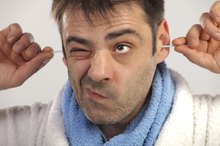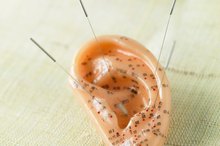Ear Wax Remedies with a Paper Cone
While ear candling has deep historical roots, evidence suggests that it is not a safe or effective practice for removing excessive ear wax 1. The practice involves placing a cone-shaped candle inside your ear, tilting your head to one side, and lighting the other end of the candle. Ideally you have a plate attached to the candle above the ear to protect your head from hot wax as the candle burns.
If you are experiencing serious medical symptoms, seek emergency treatment immediately.
Practitioners
One way to try this controversial remedy is to visit a practitioner specializing in ear coning or candling. The Coning/Candling Company, located in Pacific Palisades, Calif. offers this service at a rate of $120 for a one hour and 20 minute session as of 2010 2. The company use a series of six cones, three per ear, and trains you to do it yourself at home. The practitioners claim that the cones remove not only wax, but environmental toxins such as chemicals from plastics and prescription drugs. They base this claim on the incorrect assumption that the eustacian tubes of the ears are part of the body's lymphatic system.
- One way to try this controversial remedy is to visit a practitioner specializing in ear coning or candling.
- The Coning/Candling Company, located in Pacific Palisades, Calif. offers this service at a rate of $120 for a one hour and 20 minute session as of 2010 2.
Store-Bought
How to Use Ear Cones
Learn More
You can also purchase ear candles at your local health or nutrition store or online. For as low as $2 for unbleached cotton ear candles to as high as $14 for a pair of rose-oil beeswax ear candles as of 2010, you can follow the instructions on the package for this home remedy. However, the Food and Drug Administration issued prohibits companies from marketing the medical benefits of ear candles, as they are not supported by research.
Make-Your-Own
Another possibility is making your own ear candles by rolling newspaper into a cone and soaking it with wax. Historically, people made them by shaping a cone from pottery and then blowing smoke into the cone. Some ear candlers use herbs or oils for various medicinal or spiritual reasons.
Risks
Asian Ear Wax Removal
Learn More
While the benefits are unsubstantiated and sometimes sound bizarre, the risks are clear. The Center for Devices and Radiological Health classifies ear cones or candles as dangerous devices, posing a risk with the close proximity of the burning flame to the person's face. Doctors have reported a good number of cases involving burns to the skin, blocked ear canals and a perforated eardrum. There is also the risk of fire itself, causing one known death to the ear candle user.
- While the benefits are unsubstantiated and sometimes sound bizarre, the risks are clear.
- The Center for Devices and Radiological Health classifies ear cones or candles as dangerous devices, posing a risk with the close proximity of the burning flame to the person's face.
What the Evidence Says
In a nutshell, when you open the cone, what you see appears to be wax and debris that the vacuum of the ear candle sucked from your ear. However, researchers have found that this is simply the melted wax of the candle itself, discolored by its smoke. As far as effectiveness in removing ear wax, even The Coning/Candling Company admits that your ear wax will replenish itself usually within 24 hours 2.
- In a nutshell, when you open the cone, what you see appears to be wax and debris that the vacuum of the ear candle sucked from your ear.
Related Articles
References
- Quack Watch: Why Ear Candling Is Not a Good Idea
- The Coning/Candling Company: The Ancient Art Of Ear Coning
- Seely DR, Quigley SM, Langman AW. Ear candles--efficacy and safety. Laryngoscope. 1996;106(10):1226-9. doi:10.1097/00005537-199610000-00010
- Rafferty J, Tsikoudas A, Davis BC. Ear candling: should general practitioners recommend it? Can Fam Physician. 2007;53(12):2121–2122.
- U.S. Food and Drug Administration. Import Alert 77-01. 2018.
- Schwartz SR, Magit AE, Rosenfeld RM, et al. Clinical Practice Guideline (Update): Earwax (Cerumen Impaction). Otolaryngol Head Neck Surg. 2017;156(1_suppl):S1-S29. doi:10.1177/0194599816671491
- Jabor MA, Amadee RG. Cerumen impaction. Journal of the La State Medical Society. 1977:149;358-62.
- Roeser RJ, Ballachanda BB. Physiology, pathophysiology, and anthropology/epidemiology of human ear canal secretions. Journal of the American Academy of Audiology. 1997:8;391-400.
- Seely DR, Quigley SM, Langman AW. Ear candles - efficacy and safety. Laryngoscope. 1996:106;1226-9.
Writer Bio
Katie Schroeder-Smith published her first article in 2001 in the journal "Occupational Therapy in Health Care." She has since contributed to the "Life Skills Management" manuals and "Frederick's Child Magazine." Schroeder-Smith is an occupational therapist certified in sensory integration and yoga. Schroeder-Smith attended the University of North Carolina and holds a Master of Occupational Therapy from Nova Southeastern University.








